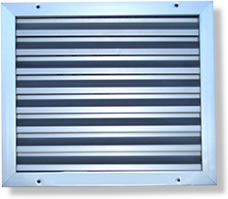
For the French museum, see the Louvre
A louver (or louvre in British English, from French l'ouvert; "the open one") is a frame with horizontal and vertical slats, which are angled to admit light and air, but to keep out rain and sun shine (or noise, in some cases). As building management services has improved and technology has quickly changed, these louvers have been automated to save on overall cost while providing a pleasant living environment inside buildings.
Louvers originated in the Middle Ages as lantern-like constructions that were fitted on top of roof holes in large kitchens to serve as ventilation while keeping out rain and snow. They were originally rather crude constructions consisting merely of a barrel. Later they evolved into more elaborate designs made of pottery, taking the shape of faces where the smoke and steam from cooking would pour out through the eyes and mouth, or into constructions that were more like modern louvers, with slats that could be opened or closed by pulling on a string.
No comments:
Post a Comment